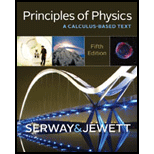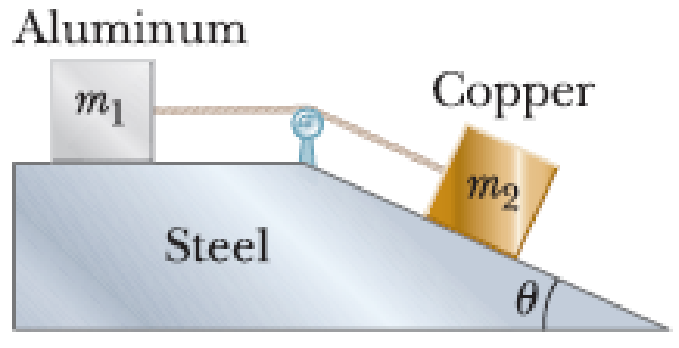
Principles of Physics: A Calculus-Based Text
5th Edition
ISBN: 9781133104261
Author: Raymond A. Serway, John W. Jewett
Publisher: Cengage Learning
expand_more
expand_more
format_list_bulleted
Concept explainers
Textbook Question
Chapter 5, Problem 46P
An aluminum block of mass m1 = 2.00 kg and a copper block of mass m2 = 6.00 kg are connected by a light string over a frictionless pulley. They sit on a steel surface as shown in Figure P5.46, where θ = 30.0°. (a) When they are released from rest, will they start to move? If they do, determine (b) their acceleration and (c) the tension in the string. If they do not move, determine (d) the sum of the magnitudes of the

Figure P5.46
Expert Solution & Answer
Trending nowThis is a popular solution!

Students have asked these similar questions
pls help on these
pls help on these
20. Two small conducting spheres are placed on top of insulating pads. The 3.7 × 10-10 C sphere is fixed whie
the 3.0 × 107 C sphere, initially at rest, is free to move. The mass of each sphere is 0.09 kg. If the spheres
are initially 0.10 m apart, how fast will the sphere be moving when they are 1.5 m apart?
Chapter 5 Solutions
Principles of Physics: A Calculus-Based Text
Ch. 5.1 - You press your physics textbook flat against a...Ch. 5.1 - A crate is located in the center of a flatbed...Ch. 5.1 - You are playing with your daughter in the snow....Ch. 5.2 - You are riding on a Ferris wheel (Fig. 5.8) that...Ch. 5.3 - Which of the following is impossible for a car...Ch. 5.3 - A bead slides freely along a curved wire lying on...Ch. 5.4 - Consider a sky surfer falling through air, as in...Ch. 5 - The driver of a speeding empty truck slams on the...Ch. 5 - The manager of a department store is pushing...Ch. 5 - An object of mass m moves with acceleration a down...
Ch. 5 - An office door is given a sharp push and swings...Ch. 5 - Prob. 5OQCh. 5 - A pendulum consists of a small object called a bob...Ch. 5 - A door in a hospital has a pneumatic closer that...Ch. 5 - The driver of a speeding truck slams on the brakes...Ch. 5 - A child is practicing for a BMX race. His speed...Ch. 5 - A large crate of mass m is placed on the flatbed...Ch. 5 - Before takeoff on an airplane, an inquisitive...Ch. 5 - Prob. 12OQCh. 5 - As a raindrop falls through the atmosphere, its...Ch. 5 - An object of mass m is sliding with speed vi at...Ch. 5 - A car is moving forward slowly and is speeding up....Ch. 5 - Prob. 2CQCh. 5 - Prob. 3CQCh. 5 - Prob. 4CQCh. 5 - Prob. 5CQCh. 5 - Prob. 6CQCh. 5 - Prob. 7CQCh. 5 - Prob. 8CQCh. 5 - Prob. 9CQCh. 5 - Prob. 10CQCh. 5 - It has been suggested that rotating cylinders...Ch. 5 - Prob. 12CQCh. 5 - Why does a pilot tend to black out when pulling...Ch. 5 - Prob. 1PCh. 5 - Prob. 2PCh. 5 - Prob. 3PCh. 5 - Prob. 4PCh. 5 - Prob. 5PCh. 5 - The person in Figure P5.6 weighs 170 lb. As seen...Ch. 5 - A 9.00-kg hanging object is connected by a light,...Ch. 5 - Prob. 8PCh. 5 - A 3.00-kg block starts from rest at the top of a...Ch. 5 - Prob. 10PCh. 5 - Prob. 11PCh. 5 - A block of mass 3.00 kg is pushed up against a...Ch. 5 - Two blocks connected by a rope of negligible mass...Ch. 5 - Three objects are connected on a table as shown in...Ch. 5 - Why is the following situation impossible? Your...Ch. 5 - Prob. 16PCh. 5 - A light string can support a stationary hanging...Ch. 5 - Why is the following situation impossible? The...Ch. 5 - A crate of eggs is located in the middle of the...Ch. 5 - Prob. 20PCh. 5 - Prob. 21PCh. 5 - A roller coaster at the Six Flags Great America...Ch. 5 - Prob. 23PCh. 5 - Prob. 24PCh. 5 - Prob. 25PCh. 5 - A pail of water is rotated in a vertical circle of...Ch. 5 - Prob. 27PCh. 5 - A child of mass m swings in a swing supported by...Ch. 5 - Prob. 29PCh. 5 - (a) Estimate the terminal speed of a wooden sphere...Ch. 5 - Prob. 31PCh. 5 - Prob. 32PCh. 5 - Prob. 33PCh. 5 - A 9.00-kg object starting from rest falls through...Ch. 5 - Prob. 35PCh. 5 - Prob. 36PCh. 5 - Prob. 37PCh. 5 - Prob. 38PCh. 5 - Prob. 39PCh. 5 - Prob. 40PCh. 5 - Prob. 41PCh. 5 - Prob. 42PCh. 5 - Consider the three connected objects shown in...Ch. 5 - A car rounds a banked curve as discussed in...Ch. 5 - Prob. 45PCh. 5 - An aluminum block of mass m1 = 2.00 kg and a...Ch. 5 - Figure P5.47 shows a photo of a swing ride at an...Ch. 5 - Why is the following situation impossible? A...Ch. 5 - A space station, in the form of a wheel 120 m in...Ch. 5 - A 5.00-kg block is placed on top of a 10.0-kg...Ch. 5 - In Example 6.5, we investigated the forces a child...Ch. 5 - Prob. 52PCh. 5 - Prob. 53PCh. 5 - Prob. 54PCh. 5 - Prob. 55PCh. 5 - Prob. 56PCh. 5 - Prob. 57PCh. 5 - Why is the following situation impossible? A book...Ch. 5 - A single bead can slide with negligible friction...Ch. 5 - An amusement park ride consists of a large...Ch. 5 - Prob. 61PCh. 5 - Prob. 62PCh. 5 - Prob. 63PCh. 5 - If a single constant force acts on an object that...
Knowledge Booster
Learn more about
Need a deep-dive on the concept behind this application? Look no further. Learn more about this topic, physics and related others by exploring similar questions and additional content below.Similar questions
- pls help on all asked questions kindlyarrow_forward19. Mount Everest, Earth's highest mountain above sea level, has a peak of 8849 m above sea level. Assume that sea level defines the height of Earth's surface. (re = 6.38 × 106 m, ME = 5.98 × 1024 kg, G = 6.67 × 10 -11 Nm²/kg²) a. Calculate the strength of Earth's gravitational field at a point at the peak of Mount Everest. b. What is the ratio of the strength of Earth's gravitational field at a point 644416m below the surface of the Earth to a point at the top of Mount Everest? C. A tourist watching the sunrise on top of Mount Everest observes a satellite orbiting Earth at an altitude 3580 km above his position. Determine the speed of the satellite.arrow_forwardpls help on allarrow_forward
- pls help on allarrow_forward6. As the distance between two charges decreases, the magnitude of the electric potential energy of the two-charge system: a) Always increases b) Always decreases c) Increases if the charges have the same sign, decreases if they have the opposite signs d) Increases if the charges have the opposite sign, decreases if they have the same sign 7. To analyze the motion of an elastic collision between two charged particles we use conservation of & a) Energy, Velocity b) Momentum, Force c) Mass, Momentum d) Energy, Momentum e) Kinetic Energy, Potential Energyarrow_forwardpls help on all asked questions kindlyarrow_forward
- pls help on all asked questions kindlyarrow_forward17. Two charges, one of charge +2.5 × 10-5 C and the other of charge +3.7 × 10-6 C, are 25.0 cm apart. The +2.5 × 10−5 C charge is to the left of the +3.7 × 10−6 C charge. a. Draw a diagram showing the point charges and label a point Y that is 20.0 cm to the left of the +3.7 × 10-6 C charge, on the line connecting the charges. (Field lines do not need to be drawn.) b. Calculate the net electric field at point Y.arrow_forward3arrow_forward
arrow_back_ios
SEE MORE QUESTIONS
arrow_forward_ios
Recommended textbooks for you
 Physics for Scientists and Engineers: Foundations...PhysicsISBN:9781133939146Author:Katz, Debora M.Publisher:Cengage Learning
Physics for Scientists and Engineers: Foundations...PhysicsISBN:9781133939146Author:Katz, Debora M.Publisher:Cengage Learning Principles of Physics: A Calculus-Based TextPhysicsISBN:9781133104261Author:Raymond A. Serway, John W. JewettPublisher:Cengage Learning
Principles of Physics: A Calculus-Based TextPhysicsISBN:9781133104261Author:Raymond A. Serway, John W. JewettPublisher:Cengage Learning College PhysicsPhysicsISBN:9781305952300Author:Raymond A. Serway, Chris VuillePublisher:Cengage Learning
College PhysicsPhysicsISBN:9781305952300Author:Raymond A. Serway, Chris VuillePublisher:Cengage Learning Physics for Scientists and Engineers with Modern ...PhysicsISBN:9781337553292Author:Raymond A. Serway, John W. JewettPublisher:Cengage Learning
Physics for Scientists and Engineers with Modern ...PhysicsISBN:9781337553292Author:Raymond A. Serway, John W. JewettPublisher:Cengage Learning Physics for Scientists and EngineersPhysicsISBN:9781337553278Author:Raymond A. Serway, John W. JewettPublisher:Cengage Learning
Physics for Scientists and EngineersPhysicsISBN:9781337553278Author:Raymond A. Serway, John W. JewettPublisher:Cengage Learning Classical Dynamics of Particles and SystemsPhysicsISBN:9780534408961Author:Stephen T. Thornton, Jerry B. MarionPublisher:Cengage Learning
Classical Dynamics of Particles and SystemsPhysicsISBN:9780534408961Author:Stephen T. Thornton, Jerry B. MarionPublisher:Cengage Learning

Physics for Scientists and Engineers: Foundations...
Physics
ISBN:9781133939146
Author:Katz, Debora M.
Publisher:Cengage Learning

Principles of Physics: A Calculus-Based Text
Physics
ISBN:9781133104261
Author:Raymond A. Serway, John W. Jewett
Publisher:Cengage Learning

College Physics
Physics
ISBN:9781305952300
Author:Raymond A. Serway, Chris Vuille
Publisher:Cengage Learning

Physics for Scientists and Engineers with Modern ...
Physics
ISBN:9781337553292
Author:Raymond A. Serway, John W. Jewett
Publisher:Cengage Learning

Physics for Scientists and Engineers
Physics
ISBN:9781337553278
Author:Raymond A. Serway, John W. Jewett
Publisher:Cengage Learning

Classical Dynamics of Particles and Systems
Physics
ISBN:9780534408961
Author:Stephen T. Thornton, Jerry B. Marion
Publisher:Cengage Learning
Newton's Second Law of Motion: F = ma; Author: Professor Dave explains;https://www.youtube.com/watch?v=xzA6IBWUEDE;License: Standard YouTube License, CC-BY